African Union: The end of the CFA franc (from the GEAB 110 / Dec 2016)
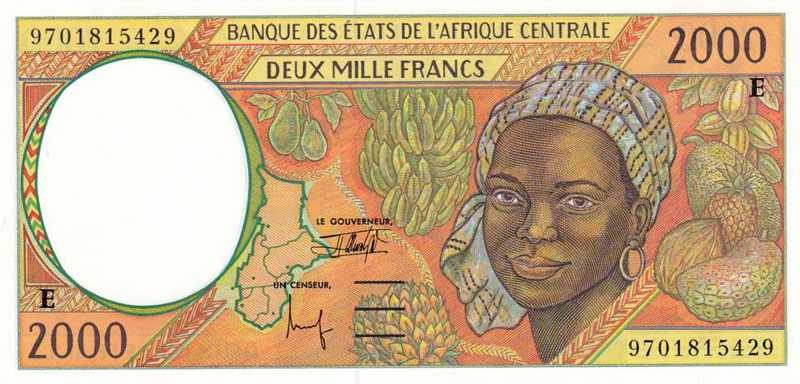
Africa! The second largest continent in the world after Asia, both in size and population[1], and also one of the poorest[2] is shaken by internal conflicts and wars. But above all, it’s a continent with one of the youngest age pyramids in the world[3]; so many opportunities open for the future and for hope in this region which will experience great challenges of development, modernity and opening-up in the coming decades.
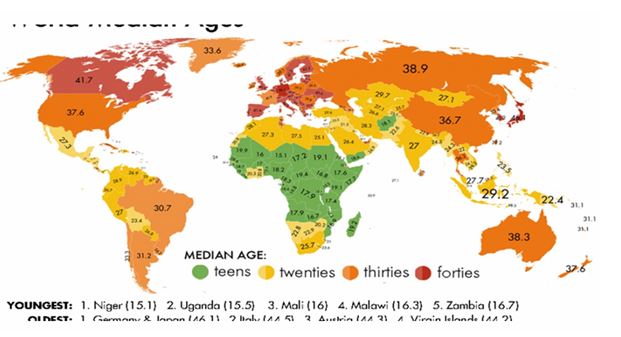
Distribution of youth below 20 year olds in the world – Source: PRI GlobalPost
Youth, mobility, modernity… alongside other factors such as education, consumption and democratisation, are all broadening the horizons for the emergence of a new society and a new economic growth, already included in the globalisation. Immigration and thus integration into other regions, new technologies and therefore immersion in globalisation, those are already vectors of undeniable and unavoidable exchanges, guaranteeing the outsourcing of the African society, and helping the rooting of its wealth.
The end of the 1990s, within the collapse of the USSR (and thus the rupture of all ties between the African countries and communist obedience), the tragedy of Rwanda, and the end of the apartheid regime in South Africa, marked together a turning point in the African leaders’ awareness of the need to restore order to their continent. As a consequence, the African Union[4] (AU), or the NEPAD[5] (New Development Project for Africa) emerged.
The global systemic crises have shaken the world since 2008 and has hit Africa, which is an emerging but hyper-fragile continent; especially economically, financially and therefore socially. The last colonial-derived elites[6] disappeared and the new democratic experiences stuttered (the same movement could be encountered in South America). All those indicators, but also the place South Africa took in the new multipolar environment and the important role of the BRICS and the effects of the strategic retreat of the Western world[7], created some sort of awareness among Africans about their place in the world. As a consequence, tools were developed for the strengthening of regional economic communities on the one hand and the AU and NEPAD on the other; all launched within a wide African evolutional project included in the Agenda 2063.
One road: Unlocking Africa – “one belt, one road, one continent” project adjusted for Africa
All the world’s actors say it: priority must be given to Africa’s development for Africans; through industrial production, agriculture, new technologies, energy, fighting unemployment and the stabilisation of the population (or at least avoid excessive migratory flows), …
Yes, but to do this, the opening-up of the African regions becomes priority number one. The take off of an internal market can not be ensured if the conditions and tools are not up to the challenges. Building factories makes no sense if access to materials and human resources delivery can not be provided. Africa does not own enough infrastructure, roads, railways, ports or air hubs, to meet its continental development needs, and enable it to open up the regions. Africa needs to ensure the development of rural areas; help emerge an intra-African market at a continental scale which benefits Africans; or face the chaotic isolation of its urban areas. The latter are confronted with traffic congestion, pollution and insecurity … Not to mention the development project of a coastal megalopolis of more than 1,000 kilometres and some 100 million inhabitants from Douala to Abidjan on the horizon of 2050[8]. We could very well understand the stakes of opening work sites: buildings, roads, public transportation, schools and hospitals.
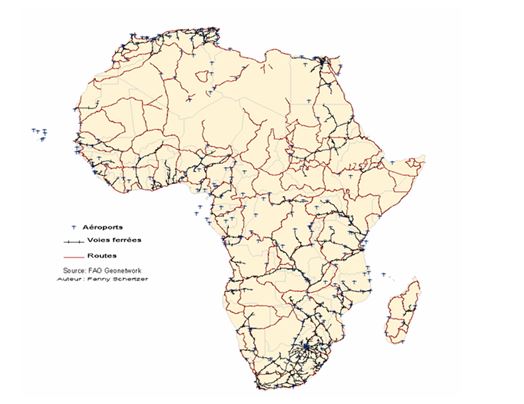
Transportation in Africa: airports, railways, roads. Source: Africa Onweb
Africa is, we repeat, the second largest continent in the world, but nevertheless it has only 7% of the total global network and its railway infrastructure remains obsolete. Hardly a third of African inhabitants from rural areas live in contact with roads, and of course this has a cost in the price of goods traded on the continent[9]. But there is also a human cost, notably to ensure population movements occur in a more efficient, just and humane way (high migration, but camps are not the right solutions), to help fix the population in rural/peri-urban areas (example: Rwanda) and to avoid the over-saturation of main cities[10]. That is how projects for the construction of metros, tramways, and electric buses usually occur[11]…
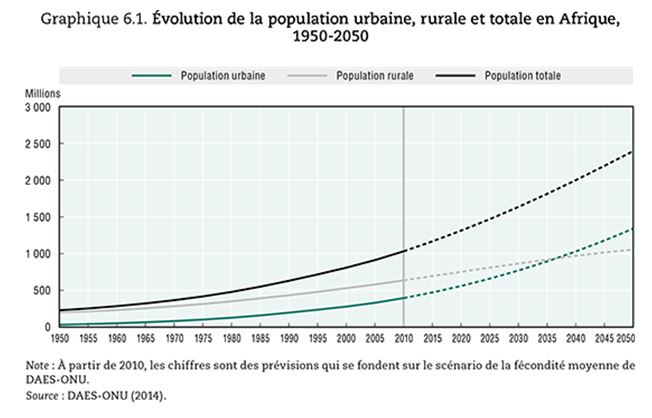
The development of infrastructure also requires a capacity for maintenance and hence the training of human resources and financial investments to ensure sustainability.
Unlike the Western “settlers”, China and the BRICS claim to be working to build Africa, not to plunder its resources[12]. For example, the BRICS countries’ investment plan seeks to support infrastructure to enable the continent to develop its industry, as well as its agriculture and the trading of goods and services[13]. The BRICS’ response, and especially China’s[14], strongly supported by the NDB (BRICS New Development Bank), is the application of the principle of developing the Silk Road: “one belt, one road, one continent”[15], and become Africa’s builders, for its communication networks to enable continental and international connectivity (roads, sea lanes and ports, rail networks and energy supply networks). The Silk Road extends its ramifications from the Indian Ocean to East Africa, but also to North and West Africa via Spain[16]. A belt to the east, a belt to the west… and hundreds of highways in between[17].
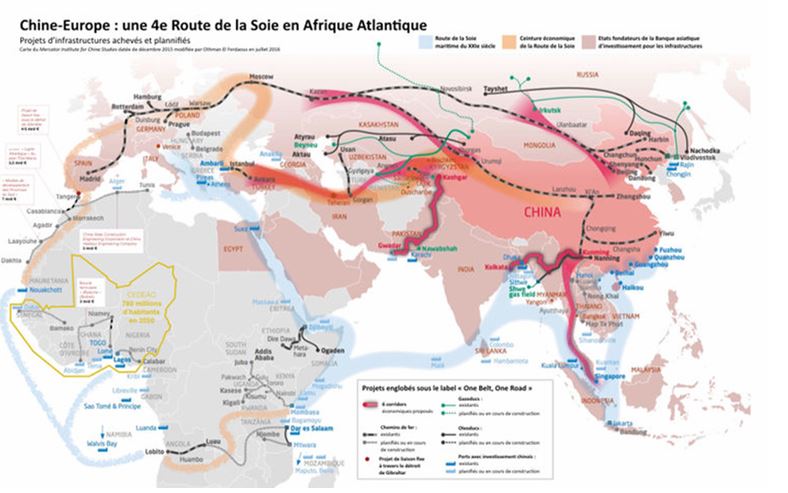 Source: Othman El Ferdaous
Source: Othman El Ferdaous
The Europeans are obviously also concerned, as Angela Merkel states that African “welfare” is in the interest of Germany[18], or companies such as Engie-Ineo commit to complete their project in 26 months. Competition on the continent is tough, isn’t it?[19].
_____________________________________
[2] 47% of the African population lives below the poverty level, with less than 1,25 US$ / day.
[4] See the AU and Wikipedia websites
[5] See the NEPAD and Wikipedia websites
[6] Particularly the war in Libya in 2011 and Kadafhi’s death; one of the heralds of the « United States of Africa »
[7] Read the GEAB 101, 15/01/2016
[8] Source: Afrique Actu, 26/05/2010
[9] Source: Les Echos, 30/03/2016
[10] The headache about urban transportation is no news. Source: Afrik.com, 22/10/2006
[11] The French Railway National Company (SNCF) in Ivory Coast and Senegal: Jeune Afrique, 19/10/2016 – China in Ethiopia, CNN, 14/10/2015 or South Africa: AFK Insider, 24/10/2016
[12] A “One Belt, One Road and One Continent” strategy can help developing countries break the bottleneck of their development by introducing a “blood-making” mechanism to help them develop on their own. Source : China Daily, 20/01/2015
[13] Source: The Diplomat, 29/09/2016
[14] The trade exchanges between India and Africa increased from $25 billion in 2006 to $70 billion in 2014, while China’s were estimated at $222 billion in 2014. Source: The Diplomat, 07/07/2016
[15] Read also: Financial Afrik, 26/02/2016
[16] In 2014, China created the longest railway connection in the world between East China and Spain in 22 days… Source: RFI, 06/12/2014
[17] Source: South West, 31/10/2016
[18] Source: Chancellerie allemande, 06/10/2016
[19] Source: All Africa, 14/12/2016


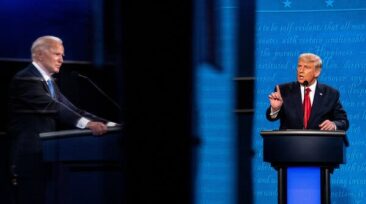

Comments